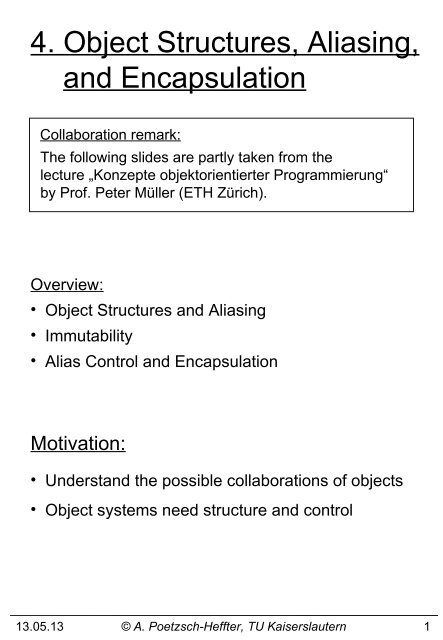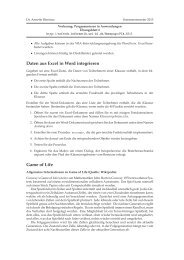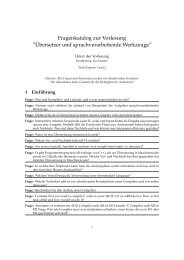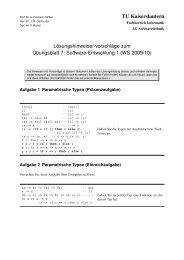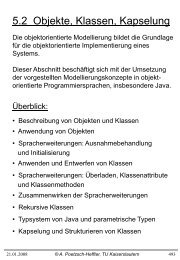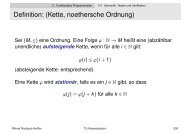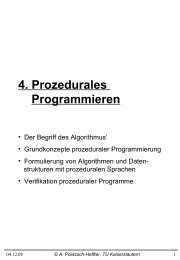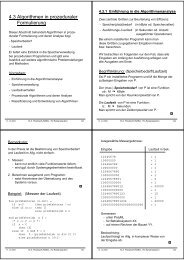4. Object Structures, Aliasing, and Encapsulation
4. Object Structures, Aliasing, and Encapsulation
4. Object Structures, Aliasing, and Encapsulation
Create successful ePaper yourself
Turn your PDF publications into a flip-book with our unique Google optimized e-Paper software.
<strong>4.</strong> <strong>Object</strong> <strong>Structures</strong>, <strong>Aliasing</strong>,<strong>and</strong> <strong>Encapsulation</strong>Collaboration remark:The following slides are partly taken from thelecture „Konzepte objektorientierter Programmierung“by Prof. Peter Müller (ETH Zürich).Overview:• <strong>Object</strong> <strong>Structures</strong> <strong>and</strong> <strong>Aliasing</strong>• Immutability• Alias Control <strong>and</strong> <strong>Encapsulation</strong>Motivation:• Underst<strong>and</strong> the possible collaborations of objects• <strong>Object</strong> systems need structure <strong>and</strong> control13.05.13© A. Poetzsch-Heffter, TU Kaiserslautern1
„Unless objects are conceptually allowed to containother objects in their entirety, there is little hope tomaster complexity in a pure object-oriented approach.... It is, therefore, <strong>and</strong> quite paradoxically,nontrivial to introduce the notion of components intoobject systems.“[ David Luckham et al. ]<strong>4.</strong>1 <strong>Object</strong> <strong>Structures</strong> <strong>and</strong> <strong>Aliasing</strong>• <strong>Object</strong>s are the basic building blocks ofobject-oriented programming.• However, interesting system components <strong>and</strong>program abstractions are almost always providedby sets of cooperating objects.Explanation:(<strong>Object</strong> structure)An object structure (Objektgeflecht) is a set ofobjects that are connected via references.13.05.13© A. Poetzsch-Heffter, TU Kaiserslautern2
Examples:(<strong>Object</strong> structures)1. A very simple structure consisting of 2 objects:listclass ArrayList {private int[ ] array;private int next;public void add( int i ) {if (next==array.length)resize( );array[ next ] = i;next++;}array:next:…arraylength:0:1:2:…}public void addElems(...)…{ … }13.05.13© A. Poetzsch-Heffter, TU Kaiserslautern3
2. A simple structure of several objects::LinkedListheader:size: 3: Entryelement:next:previous:: Entryelement:next:previous:: Entryelement:next:previous:: Entryelement:next:previous:... ... ...3. More interesting object structures can e.g. befound in graphical user interfaces.13.05.13© A. Poetzsch-Heffter, TU Kaiserslautern4
Problems:• Structural integrity ( structural invariants)• Behavior <strong>and</strong> state of an object tightly dependson other objects.• „Multiple references“ to one object ( aliasing)Explanation: (<strong>Aliasing</strong> in OO programming)An object X is aliased if two or more variables holdreferences to X. A variable can be- an instance variable- a class or static variable (global variable)- a local variable of a method incarnation,including the implicit parameter this- a formal parameter- the result of a method invocation or herintermediate expression resultsOften such a variable is called an alias of X.<strong>Aliasing</strong> is called static if all involved variables areinstance or static variables, i.e. belong to the heap.Otherwise, it is called dynamic.13.05.13© A. Poetzsch-Heffter, TU Kaiserslautern5
Desirable Aspects of <strong>Aliasing</strong>:• Consistent view to shared objects• Multiple cursors/iterators into object structures• Time <strong>and</strong> space efficiencyExamples:(Desirable aliasing)1. Address objects that capture the address of aperson or institution:- Several objects may reference an address A.- If A is modified, the referencing objects keepa consistent <strong>and</strong> up-to-date view.2. Consider a complex tree or graph structure:- The structure can be traversed byseveral iterators.- Cursors can point to nodes of current interest.3. Data structures can share objects (e.g. singlylinked lists):- avoids to copy data structures when they areenlarged or reduced in size;- saves a lot of memory space.13.05.13© A. Poetzsch-Heffter, TU Kaiserslautern6
Undesirable Aspects of <strong>Aliasing</strong>:1. Side-effects may become difficult to underst<strong>and</strong><strong>and</strong> control2. Inconsistent access to objects3. Aliases allow to by-pass interface operations<strong>4.</strong> Optimizations <strong>and</strong> formal techniques becomemore complexExamples:(Undesirable aliasing)1. Violation of invariants through aliases:- A set class uses a list class to implement thecollection. Invariant: no duplicates.- Alias to the list can lead to invariant violation.2. Inconsistent access:- An algorithm reads in different steps theattributes of an address object X (name,street, town).- Someone else modifies X while the algorithmreads its information.13.05.13© A. Poetzsch-Heffter, TU Kaiserslautern7
3. By-passing interfaces:Security breach in Java JDK 1.1.1:• Each Class-object stores array of signers• Only trusted signers get extended accessrights to the host system• Through leaking of the array of signers, amalicious applet can modify the list of signersto get extended rights• Again, access modifiers cannot prevent theproblem, because arrays are mutableprivate Identity[ ] signers;…public Identity[ ]getSigners( ) {}return signers;13.05.13© A. Poetzsch-Heffter, TU Kaiserslautern8
Forms of Alias Creation:Capturing:• Capturing occurs when objects are passed to adata structure <strong>and</strong> then stored by the datastructure.• Capturing often occurs in constructors (e.g.,streams in Java).• Problem: Alias can be used to by-pass interfaceof data structure.list1array:next:array13.05.13class ArrayList {private int[ ] array;private int next;public void addElems( int[ ] ia ){ array = ia; next = ia.length; }…}© A. Poetzsch-Heffter, TU Kaiserslautern9
Leaking:• Leaking occurs when data structure passes areference to an object which is supposed to beinternal to the outside• Leaking often happens by mistake.• Problem: Alias can be used to by-pass interfaceof data structure.list1array:next:arrayclass ArrayList {private int[ ] array;private int next;public int[ ] getElems( ){ return array; }…}13.05.13© A. Poetzsch-Heffter, TU Kaiserslautern10
General approaches to solve alias problems:- Support aliasing, but disable modifications(avoids undesirable aspects (1.), (2.) <strong>and</strong> (<strong>4.</strong>)from above)- Control aliasing <strong>and</strong> access<strong>4.</strong>2 ImmutabilityReferential transparency means that the holder ofan object reference R- does not have to care about aliases of R,- in particular, cannot observe whether aliases of Rexist (by using R).Techniques to achieve referential transparency:- immutability- uniquenessAssumption:To keep the following definitions simpler, we assumethat reading <strong>and</strong> writing to instance variables of anobject X can only be done by methods of X‘s class(possibly inherited methods).That is, objects can only be observed by methodinvocation.13.05.13© A. Poetzsch-Heffter, TU Kaiserslautern11
Explanation:(Immutability)We assume that equality for the primitive typesis defined by „==“ <strong>and</strong> for reference types bysome reasonably defined method equals.An object X is called (observationally) immutableif after termination of its constructor callany two invocationsX.m(p1,...,pn) <strong>and</strong> X.m(q1,...,qn)with pi equals qi (1≤ i ≤ n) either- yield equal results or- throw equal exceptions or- both do not terminate.A class C is called immutable if all instances of Cin any program execution are immutable.Remark:• Immutability is usually defined by prohibitingstate changes <strong>and</strong> dependency of „external“ state.• About 660 concrete classes in Java‘s st<strong>and</strong>ardlibrary are immutable (about 20%)13.05.13© A. Poetzsch-Heffter, TU Kaiserslautern12
Examples:1. Immutable class:(Immutability)class ImmutableList {private int head;private ImmutableList tail;boolean isempty(){ return tail == null; }}int head(){if( isempty() )throw new NoSuchElementException();return head;}ImmutableList tail(){if( isempty() )throw new NoSuchElementException();return tail;}ImmutableList cons( int i ) {ImmutableList aux = new ImmutableList();aux.head = i;aux.tail = this;return aux;}boolean equals( <strong>Object</strong> that ) {...}<strong>Object</strong>s of class ImmutableList are immutable foran appropriate method equals.13.05.13© A. Poetzsch-Heffter, TU Kaiserslautern13
class ImmutableList { // continued...boolean equals( <strong>Object</strong> that ) {if( that == null ||!(that instanceof ImmutableList )return false;ImmutableList tl = (ImmutableList) that;if( isempty() ) {return that.isempty();} else if( that.isempty() ) {return false;} else {return ( this.head == that.head )&& tail().equals( that.tail() );}}}2. Immutability <strong>and</strong> inheritance:There may be scenarios in which objects of typeImmutableList are not immutable:...static boolean somemethod( ImmutableList il ){if( !il.isempty() ) {return il.head() == il.head();} else return true;}13.05.13© A. Poetzsch-Heffter, TU Kaiserslautern14
class NotImmutableList extends ImmutableList{private boolean flag;boolean isempty(){ return false; }int head(){flag = !flag;if( flag ){return 7;} else return 9;}}ImmutableList cons( int i ) {return new NotImmutableList();}...ImmutableList il = new NotImmutableList();il.cons(7).cons(9);System.out.println( somemethod(il) );...The example demonstrates that subclasses can breach immutability.13.05.13© A. Poetzsch-Heffter, TU Kaiserslautern15
3. Immutable objects must not depend on globalvariables:class Global {public static int a = 5;public static int getA(){return a;}}class Immutable2 {public int alwaysTheSame() {return Global.getA();}}Immutable2-objects are not immutable!The example demonstrates that mutability can depend on global state.13.05.13© A. Poetzsch-Heffter, TU Kaiserslautern16
<strong>4.</strong> Immutable objects with varying I/O-behavior:final class Immutable3 {}private int state;public int alwaysTheSame() {}System.out.println(state++);return 47;5. Immutable objects where state changes canmake sense:Typical example: Initialization of instancevariables on dem<strong>and</strong>, i.e., not by the constructor,but prior to first use.Techniques for Realizing Immutability:Immutability is implemented using different techniques:- Access <strong>and</strong> inheritance restrictions- Immutable state (local <strong>and</strong> reachable state)- Prohibition of access to global state (direct orvia methods)13.05.13© A. Poetzsch-Heffter, TU Kaiserslautern17
Sufficient criteria for immutability of an object X:• Instance variables of X cannot be modified aftertermination of its constructor.●X is not exposed during construction.• <strong>Object</strong>s referenced by X are immutableaccording to these criteria.• Constructors can only take immutable objects asparameters.• Methods do not depend on global variables, i.e.,- They do not access global variables.- They do not invoke methods that depend onglobal variables.• Methods do not create new objects.Remarks:• The above criteria are still difficult to check:- It is difficult to show that no modifications canoccur.- Inheritance has to be controlled.• Classes like String are (almost) immutable, althoughthey modify the state <strong>and</strong> do not satisfy the abovecriteria.• Restricted forms of immutability can be checkedby tools.13.05.13© A. Poetzsch-Heffter, TU Kaiserslautern18
<strong>4.</strong>3 Alias Control <strong>and</strong> <strong>Encapsulation</strong>Explanation:(Alias control, encapsulation)Techniques for alias control avoid or alleviatealias problems by preventing certain forms ofaliasing <strong>and</strong> by guaranteeing structural invariants.Implementation techniques for alias control are:- Alias modes- Access restrictions- Read-only references/methods- <strong>Encapsulation</strong><strong>Encapsulation</strong> techniques structure the statespace of executing programs in a way that allows- to guarantee data <strong>and</strong> structural consistency by- establishing boundaries/capsules with well-definedinterfaces.13.05.13© A. Poetzsch-Heffter, TU Kaiserslautern19
Alias control <strong>and</strong> encapsulation techniques areanother approach to reduce aliasing problems:1. Side-effects are simpler to control.2. Consistent access to objects can be achieved.3. By-passing of interface operations can be avoidedOverview:• Notions of alias control• Type-based encapsulation<strong>4.</strong>3.1 Notions of Alias ControlWe need better control over the objects in an objectstructure to avoid aliasing problems.Approach: Alias modes:- Define roles of objects in object structures- Assign a tag (alias mode) to every expression to indicatethe role of the referenced object- Impose programming rules to guarantee that objects areonly used according to their alias modes13.05.13© A. Poetzsch-Heffter, TU Kaiserslautern20
Roles in <strong>Object</strong> <strong>Structures</strong>:• Interface objects that are used to accessthe structure• Internal representation of the object structure• Arguments of the object structure:LinkedList:ListItr:Entry:Entry :Entry :Entry13.05.13© A. Poetzsch-Heffter, TU Kaiserslautern21
1. Interface objects (default mode):• Interface objects are used to access thestructure• Interface objects can be used in any wayobjects are usually used (passed around,changed, etc.):LinkedList:ListItr:Entry:Entry :Entry :Entry13.05.13© A. Poetzsch-Heffter, TU Kaiserslautern22
2. Representations (rep mode):• Expressions with mode “rep” hold references tothe representation of the object structure• <strong>Object</strong>s referenced by rep-expressions canbe changed• Rep-objects must not be exported from theobject structure:LinkedList:ListItr:Entry:Entry :Entry :Entry13.05.13© A. Poetzsch-Heffter, TU Kaiserslautern23
3. Arguments (arg mode):• Expressions with mode “arg” hold references toarguments of the object structure.• <strong>Object</strong>s must not be changed through argreferences.• Arg-objects can be passed around <strong>and</strong> aliased freely.:LinkedList:ListItr:Entry:Entry :Entry :Entry13.05.13© A. Poetzsch-Heffter, TU Kaiserslautern24
Meaning of alias modes:• Alias modes describe the role of an object relativeto an interface object• Informally: references with- default mode stay in the same bubble- rep-mode go from an interface object into its bubble- arg-mode may go to any bubble.:Dictionary:LinkedList:ListItr:Entry:Entry :Entry :Entry13.05.13© A. Poetzsch-Heffter, TU Kaiserslautern25
Example:(Alias modes as annotations)In programs, alias modes can be expressed bycomments/annotations tagging types:class LinkedList {private /* rep */ Entry header;private int size;}public void add( /* arg */ <strong>Object</strong> o ) {/* rep */ Entry newE =new /* rep */ Entry( o, header, header.previous );… }class Entry {private /* arg */ <strong>Object</strong> element;private Entry previous, next;public Entry( /* arg */ <strong>Object</strong> o, Entry p, Entry n ) { … }}13.05.13© A. Poetzsch-Heffter, TU Kaiserslautern26
Programming Discipline (simplified):Rule 1: No role confusion- Expressions with one alias mode must not beassigned to variables with another modeRule 2: No representation exposure- rep-mode must not occur in an object’s interface- Methods must not take or return rep-objects- Fields with rep-mode may only be accessed on thisRule 3: No argument dependence- Implementations must not depend on the stateof argument objectsThe following examples illustrate these rules.13.05.13© A. Poetzsch-Heffter, TU Kaiserslautern27
Example:(Role confusion)• Array is internal representation of the list• Method addElems confuses alias modesclass ArrayList {private /* rep */ int[ ] array;private int next;}public void addElems( int[ ] ia ) {array = ia;next = ia.length;}…Clean solution requires array copy:public void addElems( int[ ] ia ) {array = new /* rep */ int[ ia.length ];System.arraycopy (ia, 0, array, 0, ia.length );next = ia.length;}13.05.13© A. Poetzsch-Heffter, TU Kaiserslautern28
Example:(Representation exposure)- Rep-objects can only be referenced- by their interface objects- by other rep-objects of the same object structure- Rep-objects can only be modified- by methods executed on their interface objects- by methods executed on rep-objects of the sameobject structure- Rep-objects are encapsulated inside the objectstructureli1:ArrayListarray:next:arrayexposesrepresentation13.05.13© A. Poetzsch-Heffter, TU Kaiserslautern29
Example:(Argument dependencies)class Task {int prio;...}class PriorityQueue {Vector tasks = new Vector();/*@ invariant@ (\forall int i,j;@ 0
<strong>4.</strong>3.2 Type-based <strong>Encapsulation</strong>Type systems can be used to guarantee encapsulationinvariants:- <strong>Encapsulation</strong> at the package level: confined types- Further structuring techniques<strong>Encapsulation</strong> at the Package Level:Goal:Guarantee that objects of particular type can only beaccessed <strong>and</strong> manipulated by the classes of onepackage.Approach:1. Consider a package P as a capsule containing theobjects of the classes in P. The capsules are disjoint.2. Mark a type T (interface/class) of P as confinedif objects of type T should only be manipulated byprogram code in P. We say as well that theseobjects are confined.3. Define rules guaranteeing that references of confinedobjects of P are only stored in instance variables,parameters <strong>and</strong> local variables of objects of P.13.05.13© A. Poetzsch-Heffter, TU Kaiserslautern31
outside Ppackage Pinside P:S,confined:T,normalencapsulationerror:U,normalpackage Q13.05.13© A. Poetzsch-Heffter, TU Kaiserslautern32
Connection with type systems:• Each variable gets as extended type information:- the package to which it belongs (implicit)• Each object gets as extended type information:- the package to which it belongs (implicit)- information whether confined or normal• <strong>Encapsulation</strong> errors (analogous to type errors) occurif a variable v of package P references a confinedobject X of a package Q different from P. Invariant:If v references some confined X, then v <strong>and</strong> Xbelong to the same package.• <strong>Encapsulation</strong> errors are excluded by staticallycheckable rules (analogous to type conditions/rules).We consider an extension to Java by confined types:J. Vitek, B. Bokowski: Confined types in Java.Software: Practice & Experience, 31(6):507-532, 2001.Remark:The study of the encapsulation rules is of generalinterest for the development of OO-programs.13.05.13© A. Poetzsch-Heffter, TU Kaiserslautern33
Scenarios in which references are exported (1-6):package inside;public class C extends outside.B {public void putReferences() {C c = new C();/*1*/ outside.B.c1 = c;/*2*/ outside.B.storeReference(c);/*3*/ outside.B.c3s = new C[]{c};/*4*/ calledByConfined();/*5*/ implementedInSubclass();/*6*/ throw new E();}public void implementedInSubclass(){}/*7*/ public static C f = new C();/*8*/ public static C m(){ return new C();}/*9*/ public static C[] fs= new C[]{new C()};/*10*/ public C() { }}public class E extends RuntimeException{}13.05.13© A. Poetzsch-Heffter, TU Kaiserslautern34
Scenarios in which references are imported (7-10):package outside;public class B {/*1*/ public static inside.C c1;/*2*/ public static void storeReference(inside.C c2){// store c2}/*3*/ public static inside.C[] c3s;/*4*/ public void calledByConfined(){// store this}static void getReferences() {/*7*/ inside.C c7 = inside.C.f;/*8*/ inside.C c8 = inside.C.m();/*9*/ inside.C[] c9s = inside.C.fs;/*10*/ inside.C c10 = new inside.C();D d = new D();try {d.putReferences();/*6*/ } catch (inside.E ex) {// store ex}}}class D extends inside.C {/*5*/ public void implementedInSubclass(){// store this} }13.05.13© A. Poetzsch-Heffter, TU Kaiserslautern35
Explanation:A type is called confined(confined, anonymous)- if it is declared with the keyword confined or- if it is an array type with a confined component type.A set of methods <strong>and</strong> constructors can be declaredas anonymous if the following properties hold:A1: The reference this can only be used foraccessing fields <strong>and</strong> calling anonymous methodsof the current instance or for object referencecomparison.A2: Anonymity of methods <strong>and</strong> constructors must bepreserved when overriding methods.A3: Constructors called from an anonymous constructormust be anonymous.A4: Native methods may not be declared anonymous.13.05.13© A. Poetzsch-Heffter, TU Kaiserslautern36
Remark:• The behavior of anonymous methods only dependson the actual parameters <strong>and</strong> the values of theinstance variables of the implicit parameter.• Anonymous methods cannot introduce new aliasesto the current receiver object.●Anonymous methods allow confined types to usemethods inherited from normal supertypes.Static <strong>Encapsulation</strong> Rules:The following rules guarantee the encapsulation:Confinement in declarations:C1: A confined class or interface must not bedeclared public <strong>and</strong> must not belong to theunnamed global package.C2: Subtypes of a confined type must be confined.13.05.13© A. Poetzsch-Heffter, TU Kaiserslautern37
Preventing widening:C3: Widening of references from a confined type toan unconfined type is forbidden in assignments,method call arguments, return statements, <strong>and</strong>explicit casts.C4: Methods invoked on a confined object musteither be non-native methods defined in aconfined class or be anonymous methods.C5: Constructors called from the constructors ofa confined class must either be defined by aconfined class or be anonymous constructors.Preventing transfer from the inside <strong>and</strong> outside:C6: Subtypes of java.lang.Throwable <strong>and</strong>java.lang.Thread must not be confined.C7: The declared type of public <strong>and</strong> protectedfields in unconfined types must not beconfined.C8: The return type of public <strong>and</strong> protectedmethods in unconfined types must not beconfined.13.05.13© A. Poetzsch-Heffter, TU Kaiserslautern38
Further Structuring Techniques:Different structuring techniques have beendiscussed in the literature in the last years.Often cited techniques:• Balloon types:P. S. Almeida: Balloon Types: Controlling Sharingof State in Data Types. ECOOP ’97.• Ownership:D. G. Clarke, J. M. Potter, J. Noble: Ownership Typesfor Flexible Alias Protection. OOPSLA ’98.Simple Ownership Types for <strong>Object</strong> Containment.ECOOP ’01.P. Müller, A. Poetzsch-Heffter: A Type System forControlling Representation Exposure in Java.Formal Techniques for Java Programs ‘00.Other approaches are:- Preventing aliasing- Write protection <strong>and</strong> readonly modes13.05.13© A. Poetzsch-Heffter, TU Kaiserslautern39
Balloon types:A type can be marked as balloon type.<strong>Object</strong>s of balloon types are called balloon objects.Idea:x:13.05.13© A. Poetzsch-Heffter, TU Kaiserslautern40
Cluster:Let G be the undirected graph with- all objects as nodes <strong>and</strong>- all references between non-balloon objects <strong>and</strong>from balloon objects to non-balloon objects asedges.A cluster is a connected subgraph of G which is notcontained in a larger connected subgraph.Internal objects:An object O is said to be internal to a balloon object Bif <strong>and</strong> only if:- O is a non-balloon object in the same cluster as B or- O is a balloon object referenced by B or by somenon-balloon object in the same cluster as B or- there exists a balloon object B‘ internal to B <strong>and</strong>O is internal to B‘.External objects:An object is said to be external to a balloon object Biff it is neither B nor internal to B.13.05.13© A. Poetzsch-Heffter, TU Kaiserslautern41
Balloon invariant:If B is an object of a ballon type then:- B is referenced by at most one instance variable.- If such a stored reference exists it is from anobject external to B.- No object internal to B is referenced by any objectexternal to B.Remark:• The invariant allows that objects referenced onlyby dynamic aliases reference internal objects.Such objects are internal to the balloon.That is why a balloon B can contain more objectsthan just the set of all objects reachable from B.• To guarantee the balloon invariant, Almeida usesthe following techniques:- Assignment of references to instance variablesof balloon objects is not always allowed.- Data flow analysis13.05.13© A. Poetzsch-Heffter, TU Kaiserslautern42
Ownership:Idea:• Introduce an ownership relation between objects:object X owns object Y.• Define encapsulation based on ownership:Only the owner may directly access his objects.• Declare the ownership relation as extended typeinformation.Example:(Ownership annotations)class Engine {void start() { ... }void stop() { ... }}class Driver { ... }class Car {rep Engine engine; // belongs to representationDriver driver;Car() {engine = new rep Engine();driver = null;}// not part of representation13.05.13© A. Poetzsch-Heffter, TU Kaiserslautern43
}rep Engine getEngine() { return engine; }void setEngine( rep Engine e){ engine=e; }void go () {if(driver!=null) engine.start();}class Main {void main() {Driver bob = new Driver(); // root ownerCar car = new Car(); // root ownercar.driver = bob;car.go();car.engine.stop();car.getEngine().stop();// fails// fails}}rep Engine e = new rep Engine();car.setEngine(e);// fails13.05.13© A. Poetzsch-Heffter, TU Kaiserslautern44
The ownership relation is a binary relation betweenobjects where objects are either normal objects orthe special owner root.The owner of an object X is determined when Xis created:- If X is created by new T(), then root is the owner.- If X is created by new rep T(), then the currentreceiver object will be the owner of X.Ownership invariant:All reference paths from a global object, that is, anobject owned by root, to some object X with owner Bgo through B.Remark:• Ownership invariant is more general than theballoon invariant. It allows references to leavethe set of owned objects.• The ownership relation in the described form is stillquite restrictive, as it only allows one owner.• Recently, a number of different ownership modelshave been developed <strong>and</strong> investigated.13.05.13© A. Poetzsch-Heffter, TU Kaiserslautern45


